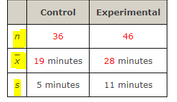> compare the effect of stress caused by noise on the ability to perform a simple task, 82 subjects were divided into two groups-36 subjects as a control group, and 46 subjects as the expermental group. Although each subject group had to perform the task while loud rock music was played. The time to finish the task was recorded for each subject and the following summary was obtained. task, the expenmenta Control Experimental 36 46 19 minutes 28 minutes 5 minutes 11 minutes (a) Find a 99% confidence interval for the difference in mean completion times (in minutes) for these two groups. (Calculate the difference as the control group - the experimental group. Round your answers to two decimal places.) min to min (b) Based on the confidence interval in part (a), is there sufficient evidence to indicate a difference in the average time to completion for the two groups? Explain. The confidence interval in part (a) has -Select- v. Hence, it is-Select- v that the means are equal. Based on the data we would conclude that -Select- v a real difference in the mean times to completion for the two groups.
q9
The confidence interval in part (a) has ---Select--- one positive and one negative endpoint, two negative endpoints, or two positive endpoints. Hence, it is ---Select--- not likely or plausible that the means are equal. Based on the data we would conclude that ---Select--- there is no evidence of or there is a real difference in the

Given Data :
 |
|
| Sample 1 | Sample 2 |
We need to construct the confidence interval for the difference between the mean completion times
First we have to test whether the variances of two samples are equal or not for calculating degrees of freedom :
Significance level = 0.99
Degrees of freedom : and
Critical values : and
F-statistic :
We noticed that :
Hence, Reject the null hypothesis of equal population variances
Step by step
Solved in 2 steps with 1 images









